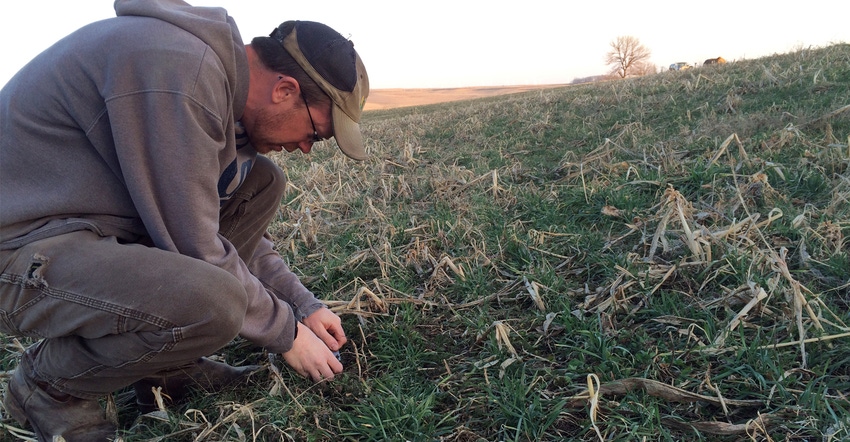July 18, 2017

“You can’t manage what you don’t measure,” says Dave Schmidt of Exira. He heard that adage some time ago, and it’s stuck with him as a management philosophy. He and wife Meg operate a diverse livestock farm in western Iowa, raising grass-fed and finished cattle and sheep, and pastured pigs and poultry. Their farm is primarily focused on grazing, but because most of their land is also suitable for row crops, management becomes especially crucial.
“We need to know if what we’re doing is working,” Dave says in terms of soil protection and farm profitability, “because almost all the ground we graze could be row crops. We have to manage as intensively as we can and make sure we can justify running cattle instead of planting row crops.”
On-farm research informs management
Practical Farmers of Iowa has helped Dave and Meg put that management philosophy into practice. Since 2011, they’ve worked with PFI to measure all different aspects of the family operation. They’ve conducted on-farm research on everything from managing flies on their cattle to grazing cover crops to pasture quality monitoring. Data they collect in the on-farm trials helps them decide which management practices to keep using and which ones don’t make sense. PFI has published several reports with the Schmidt’s on-farm research. You can find them at practicalfarmers.org/research-reports.

For farmers who raise grass-finished beef cattle, providing winter feed is often the single biggest farm expense. That’s been true for the Schmidts, so one of their ongoing research projects has been to experiment with alternatives to hay and monitor the results and costs. They’ve tried feeding several different forage sources — hay, cover crops, crop residue and stockpiled pasture — to achieve the goal of maintaining cow condition while decreasing costs.
Reduce expensive hay feeding costs
Hay is the most expensive forage to feed during winter, while the other sources provide winter grazing opportunities free of charge. Dave and Meg’s ultimate goal is to limit the feeding of hay to only one month of the year — usually around March — when gestating cows have high nutritional needs and the ground can be muddy.
The Schmidts have kept track of how much hay they’ve fed to their cattle herd for years. Here are a few findings from the last four winters of feed monitoring:
• During the winters of 2013-14 and 2014-15, cover crops and crop residue provided almost half of the winter feed needs for the herd.
• During the winter of 2015-16, the most hay was fed because the farmers weren’t able to plant cover crops the season prior.
• The least hay was fed the winter of 2016-17, due to a combination of grazing stockpiled pastures along with cover crops and crop residue.
• The Schmidts increased the size of their herd by 25% and still were able to feed less hay by grazing diverse winter forages.
Stockpiled pasture for winter feed
Because managing the interplay between cover crops, grazing and herbicide restrictions on row crop ground has become increasingly complicated on their farm, Dave says in the future they will likely stick to stockpiled pasture (pasture left to grow and reserved for later grazing) as a winter feed source.
He says stockpiling can work well with both annual and perennial forages. For stockpiling a perennial, cool-season pasture, you first have to pick a well-suited field. Dave says while he wouldn’t plant fescue, choosing a pasture that has lots of fescue in it can be a good choice for stockpiling because it stays greener longer.
Last year in the field he intended to store the stockpiled forage, he let cattle graze once from early May to mid-June and then again from mid-July to early August. After that, he let the pasture rest until dormancy and grazed it again in January.
He says one reason they were able to get a lot of grazing out of the stockpiled pasture was because he’s OK with grazing it down a bit shorter — around 4 inches as opposed to the 6 to 8 inches he would typically try to leave in spring or summer. “And the forage quality was incredible,” Dave says, “generally higher than the forage quality of hay.” He does wait to graze the stockpiled pasture until last in the spring rotation, to give it a chance to recover.
Making better land-use decisions
Dave says stockpiling can work with an annual pasture, too, but it’s more input intensive. “With an annual forage, you usually need fertilizer, you have to plant every year, and you should probably do something for weed management,” he says. “It’s just a lot more expensive and labor-intensive than a cool-season pasture.” But, he says, it’s a good way for an expanding grass-based operation like his to transition to perennial pastures.
This year, on a 23-acre field they plan to establish perennial pasture on next year, he planted oats in March. In June, he cut and wrapped the green oats for hay and immediately planted a warm-season annual forage mix containing sorghum-sudangrass and other species. He says they intend to graze that throughout the summer, bale and wrap it in early fall, and graze the regrowth in December or January after it winterkills.
Through Dave and Meg’s research with PFI, they were able to quantify their income from grazing what could be good crop ground and pinpoint the practices that provide the most bountiful and economical winter feed. This research allows them to confidently justify their alternative land use.
Get help for on-farm trials
What do you want to measure on your farm? If you’re a member of Practical Farmers of Iowa, PFI will work with you to design on-farm research to improve your farming operation. If you’re not, you can join today. It costs $60 a year for a farm membership; assistance with on-farm research is one of the many perks. For information on PFI’s on-farm research program or to become a member, contact Stefan Gailans at [email protected], 515-232-5661 or practicalfarmers.org/join.
Ohde writes for Practical Farmers of Iowa.
About the Author(s)
You May Also Like






